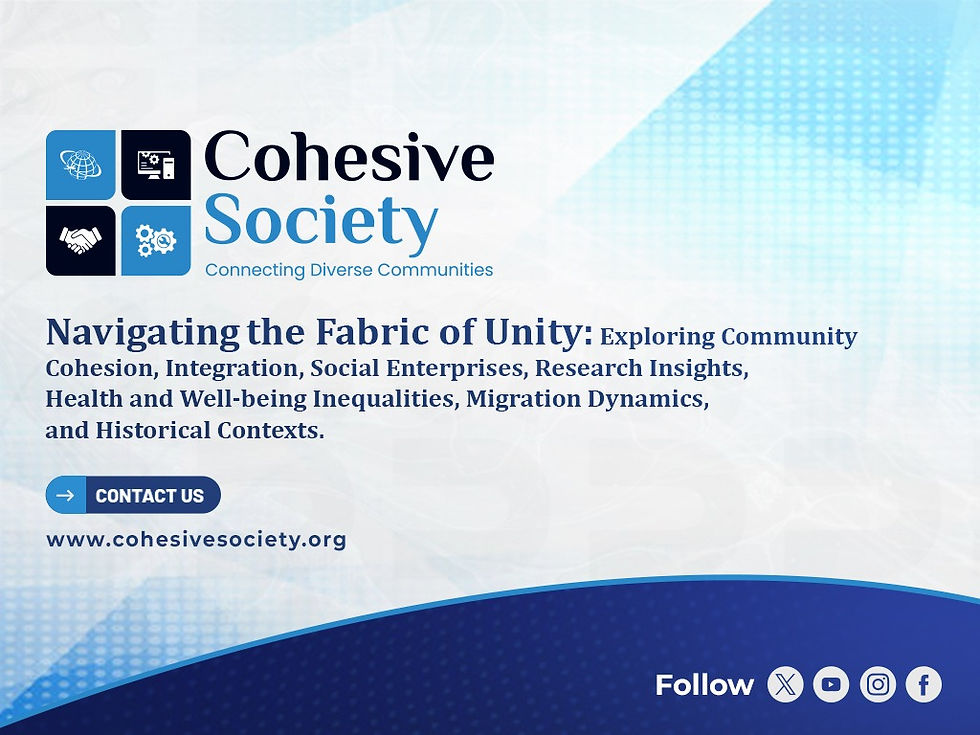Health Inequalities within the Bangladeshi Migrant Community
- Cohesive Society

- Jun 3, 2023
- 3 min read
Updated: Mar 29, 2024

Introduction
This essay will explore the extent and types of health inequalities experienced by the Bangladeshi migrant community in Northampton, UK. It will delve into the reasons behind these inequalities, the individuals and systems are responsible, and propose strategies to level up the health outcomes. The essay will draw on academic research, reports, and expert opinions to provide an informed analysis.
Extent and Types of Health Inequalities
The Bangladeshi migrant community in Northampton, like many other minority communities, experiences a range of health inequalities. Several studies have indicated higher rates of chronic diseases, mental health issues, and overall poorer health outcomes among this population. For instance, a study conducted by Ahmed et al. (2019) found that Bangladeshi migrants in the UK had a higher prevalence of diabetes compared to the general population. Additionally, a report by the British Heart Foundation (2018) highlighted that individuals of Bangladeshi origin face a higher risk of coronary heart disease, stroke, and hypertension.
Furthermore, mental health disparities are prevalent within the Bangladeshi migrant community. The Migration Observatory (2019) reported that Bangladeshi migrants had higher rates of common mental health disorders, such as anxiety and depression, compared to the general population. This disparity can be attributed to various factors, including social isolation, language barriers, and cultural differences.
Reasons for Health Inequalities
Multiple factors contribute to the health inequalities faced by the Bangladeshi migrant community in Northampton. Socioeconomic factors play a crucial role, as individuals from this community often face low income, limited educational opportunities, and precarious employment. The Joseph Rowntree Foundation (2018) highlighted that nearly half of Bangladeshis in the UK live in poverty, which can restrict access to healthcare, nutritious food, and suitable living conditions.
Language barriers and cultural differences also hinder healthcare access and utilization. Many individuals within the Bangladeshi community struggle with English proficiency, which hinders their ability to navigate the healthcare system and communicate effectively with healthcare providers. Moreover, cultural beliefs and practices may influence healthcare-seeking behaviour, leading to delayed or inadequate treatment.
Systemic factors, such as institutional discrimination and unequal distribution of resources, further exacerbate health inequalities. The unequal allocation of healthcare funding, inadequate provision of culturally sensitive services, and lack of representation in healthcare leadership positions all contribute to the disparities faced by the Bangladeshi migrant community.
Blame and Responsibility
Addressing health inequalities requires a collective effort from various stakeholders. Blaming a single entity or individual would oversimplify the complex nature of the issue. The government and the healthcare system are responsible for ensuring equitable access to healthcare services. The government should allocate sufficient resources to reduce health disparities and implement policies that promote social and economic equality. Healthcare providers must strive to provide culturally sensitive care and actively engage with minority communities to understand their specific needs and concerns.
Levelling Up Health Inequalities
To level up health outcomes within the Bangladeshi migrant community, a multi-faceted approach is necessary. First, improving health literacy within the community is crucial. Providing culturally appropriate health education programs can empower individuals to make informed decisions about their health. This includes disseminating information about preventive measures, healthy lifestyles, and disease management.
Second, addressing language barriers is vital. Healthcare providers should ensure the availability of interpreters and translated materials. Additionally, training healthcare professionals to be culturally competent can enhance communication and foster trust between patients and providers.
Third, policymakers must address the socioeconomic determinants of health by investing in education, employment opportunities, and affordable housing. By tackling poverty and inequality, the government can create an environment that promotes good health for all.
Fourth, promoting community engagement and involving community leaders in decision-making processes can lead to more effective and inclusive healthcare policies. Collaboration between healthcare providers, community organizations, and policymakers can help identify and address the specific needs of the Bangladeshi migrant community.
Conclusion
The Bangladeshi migrant community in Northampton, UK, faces significant health inequalities, including higher rates of chronic diseases and mental health disorders. These disparities arise from a complex interplay of socioeconomic, cultural, and systemic factors. To level up health outcomes, collective efforts are necessary. Governments, healthcare providers, and the community must work together to address language barriers, improve health literacy, and tackle the socioeconomic determinants of health. By doing so, we can strive towards a more equitable and inclusive healthcare system that ensures the well-being of all individuals, irrespective of their background or migration status.



Comments